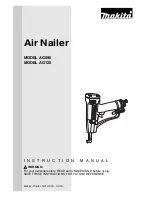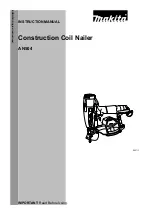
GB/IE/
CY
11
Important!
It must be possible to move the magazine slide
without applying much force. Watch out for
jammed staples and nails.
Setting the stapling force (Fig. 1)
You can pre-select the stapling force of the
electric stapler to suit the length of the staples
or nails used and the strength of the material.
To do so, set the stapling force control (3) to the
desired force. The ideal stapling force is best
determined by carrying out a trial on a test
piece.
8. Starting up
Operation (Fig. 1/5/6)
Before starting your work, always check the
filling level indicator (6) to see if the magazine
(5) contains staples or nails and is properly
closed with the magazine slide (4).
Switching on the electric stapler
Switch on the electric stapler using the On/Off
switch (2) (switch position I) directly before
starting work. The tool is now ready for
operation.
If the electric stapler is no longer in operation –
even for short periods – switch it off (Switch
position 0) to prevent unintentional operation.
Triggering shots
The built-in trigger locks prevent the electric
stapler from being triggered accidentally.
Triggering is only possible as follows:
Press the head of the electric stapler
against the material and operate the trigger
(1).
Inserting staples
Fill the staples into the magazine as shown in
Fig. 5.
Inserting nails
Fill the nails into the magazine as shown in
Fig. 6.
Stapling of textiles, fabric, leather etc.
Operate the electric stapler by pushing onto
the object in the desired place with the staple
head.
Stapling wood strips
Use only nails to staple wood strips. Do not
press the electric stapler too firmly against the
wood strip or you might damage the surface.
Filling level indicator (Fig. 1)
By observing the filling level indicator (6), it is
possible to see if the tray (5) still contains
enough staples or nails. Fill the tray (5) as
shown in “7. Insertion of the staples/nails” as
and when necessary. Avoid operation when
the tray is completely empty of staples or nails.
9. Replacing the power cable
If the power cable for this equipment is
damaged, it must be replaced by the
manufacturer or its after-sales service or
similarly trained personnel to avoid danger.
10. Cleaning, maintenance and
ordering of spare parts
Important.
Always pull out the mains power plug before
starting any cleaning work.
10.1 Cleaning
Keep all safety devices, air vents and the
motor housing free of dirt and dust as far as
possible. Wipe the equipment with a clean
cloth or blow it with compressed air at low
pressure.
We recommend that you clean the device
immediately each time you have finished
using it.
Clean the equipment regularly with a moist
cloth and some soft soap. Do not use
cleaning agents or solvents; these could
attack the plastic parts of the equipment.
Ensure that no water can seep into the
Anleitung_PET_32_4257875:_ 28.01.2009 14:31 Uhr Seite 11
Summary of Contents for 42.578.75
Page 1: ...Anleitung_PET_32_4257875 _ 28 01 2009 14 30 Uhr Seite 1...
Page 2: ...Anleitung_PET_32_4257875 _ 28 01 2009 14 30 Uhr Seite 2...
Page 3: ...3 1 2 1 5 6 7 2 3 4 4 3 4 Anleitung_PET_32_4257875 _ 28 01 2009 14 30 Uhr Seite 3...
Page 4: ...4 4 5 6 7 5 7 5 5 Anleitung_PET_32_4257875 _ 28 01 2009 14 31 Uhr Seite 4...
Page 15: ...15 Anleitung_PET_32_4257875 _ 28 01 2009 14 31 Uhr Seite 15...
Page 16: ...16 Anleitung_PET_32_4257875 _ 28 01 2009 14 31 Uhr Seite 16...
Page 17: ...17 Anleitung_PET_32_4257875 _ 28 01 2009 14 31 Uhr Seite 17...
Page 18: ...Anleitung_PET_32_4257875 _ 28 01 2009 14 31 Uhr Seite 18...




































